2021-2022学年 Unit 4 History and Traditions Part 2 Reading and Thinking 课件(27张ppt)
文档属性
| 名称 | 2021-2022学年 Unit 4 History and Traditions Part 2 Reading and Thinking 课件(27张ppt) |  | |
| 格式 | zip | ||
| 文件大小 | 8.0MB | ||
| 资源类型 | 试卷 | ||
| 版本资源 | 人教版(2019) | ||
| 科目 | 英语 | ||
| 更新时间 | 2021-11-17 12:33:52 | ||
图片预览



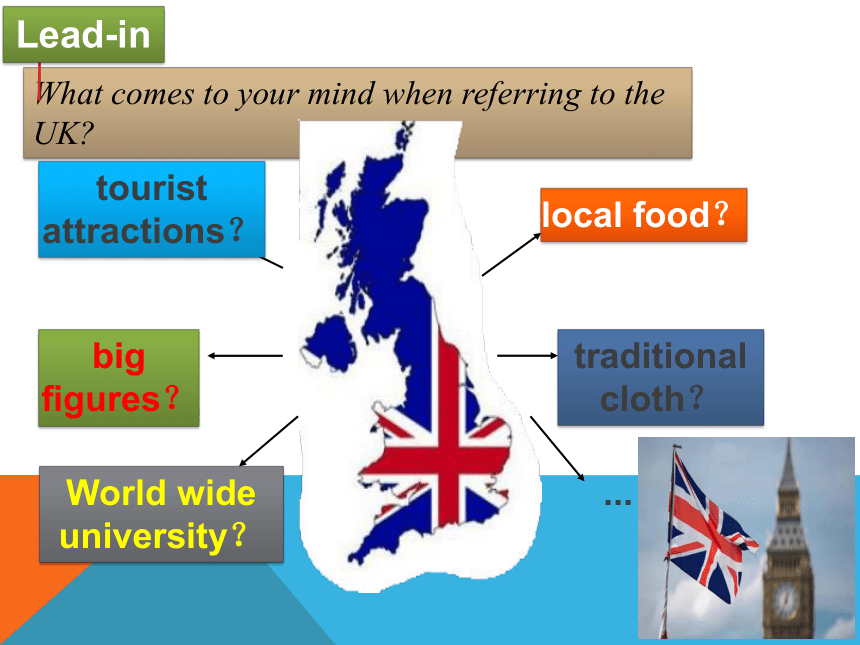

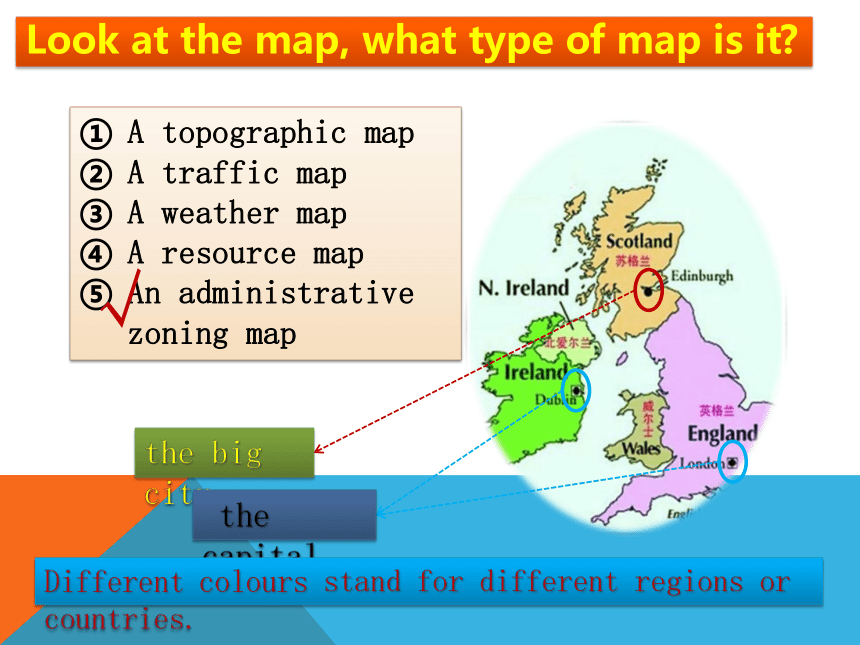
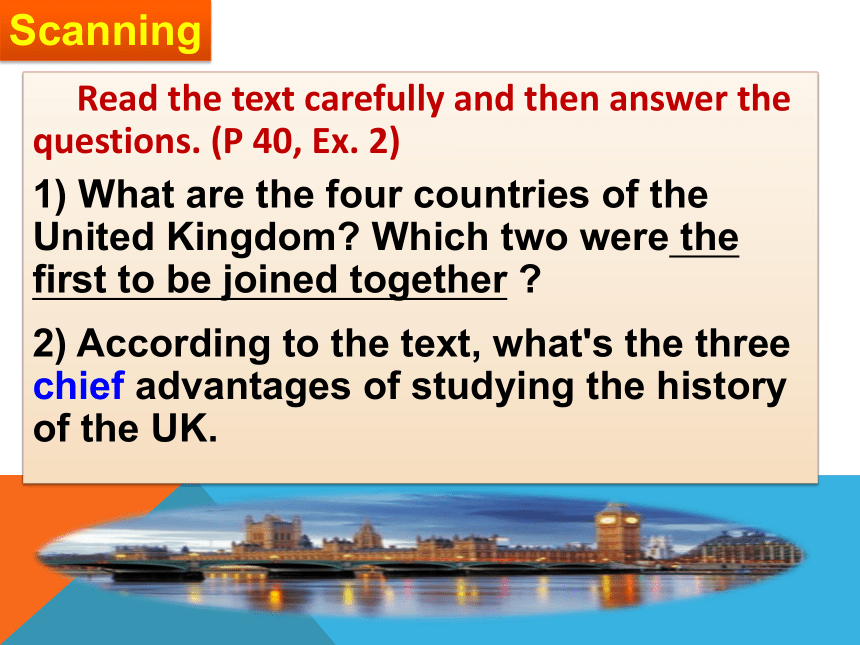
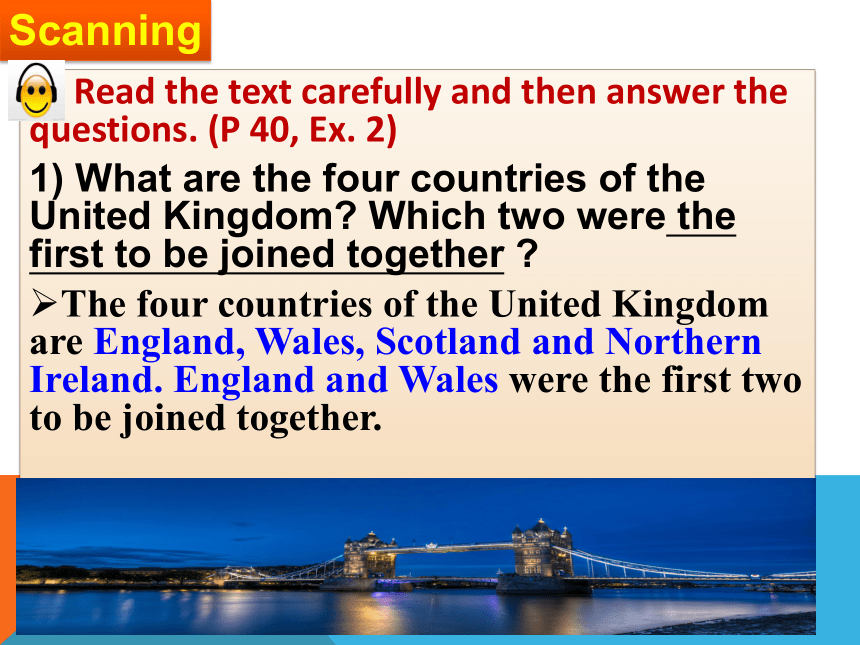
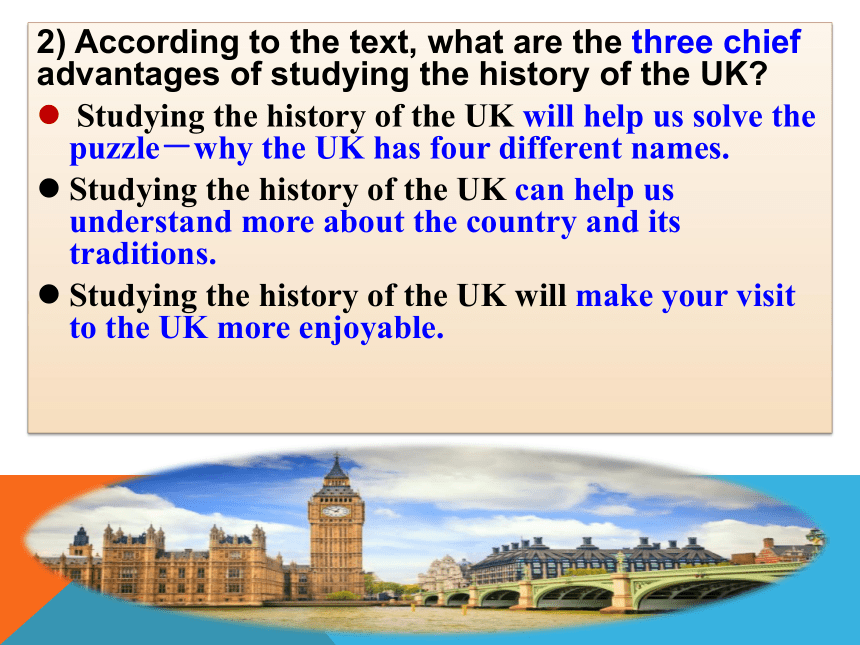
文档简介
(共27张PPT)
Unit 4 History and Traditions
Part 2 Reading and Thinking
By the end of this period, you will be able to…
1.master how to read a map and know what the map shows and what symbols mean.
2.identify the language features and the structure of the text.
3.understand the significance of learning history for understanding the social and cultural situation of a country.
4.grasp and use some words and phrases describing history through time order.
Teaching objectives:
1.How many countries does the UK consist of
A. two B. three C. four D. five
England
Wales
Scotland
quiz
Northern Ireland
Southern Ireland
2.Which is the national flag of the UK 2.
A . Canada (加拿大)
B .America (美国)
C . The union jack
3.Who rules the country
Elizabeth Ⅱ
鲍里斯·约翰逊
(Boris Johnson)
B. The Prime Minister
A. The Queen
C. both
4. Which is the bank note of the UK
A.U.S. Dollar
B . Euros ?
C.Pounds
What comes to your mind when referring to the UK
Lead-in
big figures?
tourist attractions?
World wide university?
local food?
traditional cloth?
...
Pre-reading
1.Look at the map. What does it show What is it used for
Discussion
Look at the map, what type of map is it
A topographic map
A traffic map
A weather map
A resource map
An administrative zoning map
√
the big city
the capital
Different colours stand for different regions or countries.
Read the text carefully and then answer the questions. (P 40, Ex. 2)
1) What are the four countries of the United Kingdom Which two were the first to be joined together
2) According to the text, what's the three chief advantages of studying the history of the UK.
Scanning
Read the text carefully and then answer the questions. (P 40, Ex. 2)
1) What are the four countries of the United Kingdom Which two were the first to be joined together
The four countries of the United Kingdom are England, Wales, Scotland and Northern Ireland. England and Wales were the first two to be joined together.
Scanning
2) According to the text, what are the three chief advantages of studying the history of the UK
Studying the history of the UK will help us solve the puzzle-why the UK has four different names.
Studying the history of the UK can help us understand more about the country and its traditions.
Studying the history of the UK will make your visit to the UK more enjoyable.
Before reading---Analyse the title
What's in a name
From the title, we can know that the article mainly talks about _______________________________________
_________________________________. So it may be an___________(narration/exposition/argumentation).
the name’s changes of
the UK, and it may
exposition
be about the development of history
1: What are the four countries of the United Kingdom
England, Wales, Scotland and Northern Ireland
England and Wales
While reading
Read the text again and answer the following questions.
2: Which two were the first to be joined together
3: What are the two chief advantages of studying the history of a country
The first one is to help you understand more about the country and its traditions.
4: What’s the author’s attitude towards studying the history
Supportive/positive
Review:
Great Britain
the United Kingdom
Its full name is ___________________________
____________________________, commonly known as the United Kingdom (UK).
the United Kingdom of Great
Britain and Northern Ireland
What is the main idea of the text
A brief introduction to the UK about the origins of its different names, its formation, history, traditions and culuture.
Main idea of each paragraph
A. The formation and names of the United Kingdom
B. The four groups of people in the history of the UK
C. More history and culture of the United Kingdom
D. The similarities and differences of the four countries
E. Introduce the puzzle about the four names-the United Kingdom, Great Britain, Britain, England
Para. 1.
Para. 2.
Para. 3.
Para. 4.
Para. 5.
Passage Structure Analysis
the topic
The formation and names of
the UK
The similarities and
differences between
the UK’s 4 countries
The four groups of people in the history of the UK and the changes they brought
The significance of studying the history of a country
Read again to complete the timeline:
20th century
11th century
16th century
18th century
19th century
Romans arrived
Anglo-Saxons came
Vikings came
1st century
5th century
8th century
Normans came
Wales was joined
Scotland was joined
Ireland was added
Southern Ireland broke away
Careful reading
Sort out the information according to the timeline.
When What happened What changed
Romans arrived
Anglo-Saxons came
Vikings came
1th century
5th century
8th century
towns and roads
language and way houses were built
vocabulary and names of locations across the UK
When What happened What changed
11th century
16th century
18th century
Normans conquered England after the Battle of Hastings
castles built, legal system changed, and new words from French introduced
Wales was joined to Kingdom of England
Scotland was joined to England and Wales
“Kingdom of Great Britain formed/created”
vt. 占领;征服;控制
When What happened What changed
19th century
20th century
Ireland was added
the southern part of Ireland broke away
“United Kingdom of Great Britain and Ireland formed/created”
name changed to “United Kingdom of Great Britain and Northern Ireland”
Let's read the article——What's in a name And try to draw a mindmap .
What’s in
a name
puzzle
Know about its history
16th C
18th C
19th C
20th C
work together
similarities
differences
Why four names
the Kingdom of England
England
Scotland
Wales
Ireland-- Northern Ireland
The United Kingdom of Great Britain and Northern Ireland
The United Kingdom or The UK
same flag
same currency
military defence
education systems
legal systems
traditions
football teams
Four different groups of people
The Romans-- --
The Anglo-Saxons-- --
The Vikings– --
The Normans– --
Para. 2
Para.1
Para.3
Para. 4
Para. 5
Sart with London
Enjoyable visit
history and culture
ancient and modern
old and new
past and present
How to develop para.2
time order
the Kingdom of Great Britain
1st C
building towns and roads
5th C
the language/ the way of building houses
8th C
vocabulary/ name of locations
11th C
castles built, legal system changed, and new words from French introduced
an ancient port city
countless historic sites
lots of museums with ancient relics
modern culture
What changed
When
How the UK was formed
给出游的人提建议/ 作为导游介绍一个国家的历史文化
What’s in a name
Introduce the topic.
How the UK that we talk today come .
How the four countries work together.
The general introduction of the history of the UK
A general introduction of London and the conclusion
Many people are confused by different names related to the UK. Getting to know the history will help you solve this puzzle.
In different periods Wales, Scotland were added. The southern part of Ireland broke away from the UK.
The four countries that belong to the UK work together in some areas, such as the same flag and sharing the same currency and so on.
The long and interesting history can help you understand about the country and its traditions.
London is a great place to visit that has a history –dating back to Roman times.
In the 1st century, the Romans built ________________
The names of
the UK
The similarities and
differences between
the UK’s 4 countries
____________
_____________
____________
___________
In the 16th century, ______ was joined to the Kingdom of England;
____________________, Scotland was joined to create the Kingdom of Great Britain;
In the 19th century, the Kingdom of Ireland was added to create ___________________________________________;
In the 20th century, the southern part of Ireland broke
away from UK and ______________________________
___________________ was created.
similarities
differences
flag
traditions
football teams for competitions
In the 5th century, the Anglo-Saxons introduced the beginnings of the _______, changed the way _____________
In the 8th century, the Vikings left behind ______________ and
the names of _______________
In the 11th century, the Normans conquered ________, built castles, changed ___________, and introduced __________
The
UK
currency
military defence
education systems
legal systems
the United Kingdom of Great Britain and Ireland
towns and roads
English
people built houses
new vocabulary
many locations
England
legal system
French words
In the 18th century
Wales
the United Kingdom of Great Britain and Northern Ireland
The four groups of people in the history of the UK and the changes they brought
Complete the graphic organizer and then retell the text according to it.
Complete the conversation about the UK using the phrases in their correct forms.
as well as belong to add to join to break away keep your eyes open
A: I can never remember what the UK means! There's England, Britain,
_________ Great Britain!
B: Well, it helps if you remember that there are four countries
that _________ the UK. That's why it's called the United Kingdom.
A: Four countries I must have been asleep in that part of our history
class! So the first country was England, and the others were
_________ that
B: Yes, right. First England, then Wales, then Scotland. The last country
was Ireland, but later the southern half didn't want to be ________ the
United Kingdom.
A: Oh, I remember now! The southern part __________ from Northern
Ireland, right
B: Yes, you got it well remembered! But __________________ in history
class next time!
as well as
belong to
added to
joined to
broke away
keep your eyes open
Discuss the questions in groups.
1. Why is it important to study the history and
culture of a country before visiting it
Studying a country' s history and culture before visiting it will help you understand the place better and have a more enjoyable experience. You will be able to interact better with the people and their culture and have a richer experience.
2. What important things should visitors know
about before they come to China
Visitors to China should know something about the history of the country and about the cultural traditions of the area being visited, such as the food eaten, or festivals celebrated there.
People are ________ by the names referred to as the UK. So knowing a little bit about British history will help you solve this _______.
From the 16th century, _________________________ were joined one after another to create the United Kingdom of Great Britain and Ireland. In the 20th century, the southern part of Ireland _______________ the UK resulting in the name: the United Kingdom of Great Britain and Northern Ireland, shortened as “the United Kingdom” or “the UK”.
The four countries use the same flag, the same currency and ______________. But they have different education and _____ systems. They also have their own traditions and football teams as well!
The United Kingdom has a long and interesting history. First, the Romans came, who built towns and roads. Next, _______________ arrived introducing _____________ of English and changed the way people built houses. The Vikings __________ new vocabulary, and the names of many ________. The Normans _________ England in the 11th century who built castles, made changes to the legal system and brought in French words.
There is much more to learn about the history and culture. London, as an ancient ____ has a history ______________________ Roman times with countless historic sites and museums. If you __________________, you will be surprised to find that you can see both __________________.
confused
puzzle
Wales, Scotland and Ireland
broke away from
military defence
legal
the Anglo-Saxons
the beginnings
left behind
locations
conquered
port
dating all the way back to
keep your eyes open
its past and its present
Fill in the blanks to finish the summary of the text.
Thank you
Unit 4 History and Traditions
Part 2 Reading and Thinking
By the end of this period, you will be able to…
1.master how to read a map and know what the map shows and what symbols mean.
2.identify the language features and the structure of the text.
3.understand the significance of learning history for understanding the social and cultural situation of a country.
4.grasp and use some words and phrases describing history through time order.
Teaching objectives:
1.How many countries does the UK consist of
A. two B. three C. four D. five
England
Wales
Scotland
quiz
Northern Ireland
Southern Ireland
2.Which is the national flag of the UK 2.
A . Canada (加拿大)
B .America (美国)
C . The union jack
3.Who rules the country
Elizabeth Ⅱ
鲍里斯·约翰逊
(Boris Johnson)
B. The Prime Minister
A. The Queen
C. both
4. Which is the bank note of the UK
A.U.S. Dollar
B . Euros ?
C.Pounds
What comes to your mind when referring to the UK
Lead-in
big figures?
tourist attractions?
World wide university?
local food?
traditional cloth?
...
Pre-reading
1.Look at the map. What does it show What is it used for
Discussion
Look at the map, what type of map is it
A topographic map
A traffic map
A weather map
A resource map
An administrative zoning map
√
the big city
the capital
Different colours stand for different regions or countries.
Read the text carefully and then answer the questions. (P 40, Ex. 2)
1) What are the four countries of the United Kingdom Which two were the first to be joined together
2) According to the text, what's the three chief advantages of studying the history of the UK.
Scanning
Read the text carefully and then answer the questions. (P 40, Ex. 2)
1) What are the four countries of the United Kingdom Which two were the first to be joined together
The four countries of the United Kingdom are England, Wales, Scotland and Northern Ireland. England and Wales were the first two to be joined together.
Scanning
2) According to the text, what are the three chief advantages of studying the history of the UK
Studying the history of the UK will help us solve the puzzle-why the UK has four different names.
Studying the history of the UK can help us understand more about the country and its traditions.
Studying the history of the UK will make your visit to the UK more enjoyable.
Before reading---Analyse the title
What's in a name
From the title, we can know that the article mainly talks about _______________________________________
_________________________________. So it may be an___________(narration/exposition/argumentation).
the name’s changes of
the UK, and it may
exposition
be about the development of history
1: What are the four countries of the United Kingdom
England, Wales, Scotland and Northern Ireland
England and Wales
While reading
Read the text again and answer the following questions.
2: Which two were the first to be joined together
3: What are the two chief advantages of studying the history of a country
The first one is to help you understand more about the country and its traditions.
4: What’s the author’s attitude towards studying the history
Supportive/positive
Review:
Great Britain
the United Kingdom
Its full name is ___________________________
____________________________, commonly known as the United Kingdom (UK).
the United Kingdom of Great
Britain and Northern Ireland
What is the main idea of the text
A brief introduction to the UK about the origins of its different names, its formation, history, traditions and culuture.
Main idea of each paragraph
A. The formation and names of the United Kingdom
B. The four groups of people in the history of the UK
C. More history and culture of the United Kingdom
D. The similarities and differences of the four countries
E. Introduce the puzzle about the four names-the United Kingdom, Great Britain, Britain, England
Para. 1.
Para. 2.
Para. 3.
Para. 4.
Para. 5.
Passage Structure Analysis
the topic
The formation and names of
the UK
The similarities and
differences between
the UK’s 4 countries
The four groups of people in the history of the UK and the changes they brought
The significance of studying the history of a country
Read again to complete the timeline:
20th century
11th century
16th century
18th century
19th century
Romans arrived
Anglo-Saxons came
Vikings came
1st century
5th century
8th century
Normans came
Wales was joined
Scotland was joined
Ireland was added
Southern Ireland broke away
Careful reading
Sort out the information according to the timeline.
When What happened What changed
Romans arrived
Anglo-Saxons came
Vikings came
1th century
5th century
8th century
towns and roads
language and way houses were built
vocabulary and names of locations across the UK
When What happened What changed
11th century
16th century
18th century
Normans conquered England after the Battle of Hastings
castles built, legal system changed, and new words from French introduced
Wales was joined to Kingdom of England
Scotland was joined to England and Wales
“Kingdom of Great Britain formed/created”
vt. 占领;征服;控制
When What happened What changed
19th century
20th century
Ireland was added
the southern part of Ireland broke away
“United Kingdom of Great Britain and Ireland formed/created”
name changed to “United Kingdom of Great Britain and Northern Ireland”
Let's read the article——What's in a name And try to draw a mindmap .
What’s in
a name
puzzle
Know about its history
16th C
18th C
19th C
20th C
work together
similarities
differences
Why four names
the Kingdom of England
England
Scotland
Wales
Ireland-- Northern Ireland
The United Kingdom of Great Britain and Northern Ireland
The United Kingdom or The UK
same flag
same currency
military defence
education systems
legal systems
traditions
football teams
Four different groups of people
The Romans-- --
The Anglo-Saxons-- --
The Vikings– --
The Normans– --
Para. 2
Para.1
Para.3
Para. 4
Para. 5
Sart with London
Enjoyable visit
history and culture
ancient and modern
old and new
past and present
How to develop para.2
time order
the Kingdom of Great Britain
1st C
building towns and roads
5th C
the language/ the way of building houses
8th C
vocabulary/ name of locations
11th C
castles built, legal system changed, and new words from French introduced
an ancient port city
countless historic sites
lots of museums with ancient relics
modern culture
What changed
When
How the UK was formed
给出游的人提建议/ 作为导游介绍一个国家的历史文化
What’s in a name
Introduce the topic.
How the UK that we talk today come .
How the four countries work together.
The general introduction of the history of the UK
A general introduction of London and the conclusion
Many people are confused by different names related to the UK. Getting to know the history will help you solve this puzzle.
In different periods Wales, Scotland were added. The southern part of Ireland broke away from the UK.
The four countries that belong to the UK work together in some areas, such as the same flag and sharing the same currency and so on.
The long and interesting history can help you understand about the country and its traditions.
London is a great place to visit that has a history –dating back to Roman times.
In the 1st century, the Romans built ________________
The names of
the UK
The similarities and
differences between
the UK’s 4 countries
____________
_____________
____________
___________
In the 16th century, ______ was joined to the Kingdom of England;
____________________, Scotland was joined to create the Kingdom of Great Britain;
In the 19th century, the Kingdom of Ireland was added to create ___________________________________________;
In the 20th century, the southern part of Ireland broke
away from UK and ______________________________
___________________ was created.
similarities
differences
flag
traditions
football teams for competitions
In the 5th century, the Anglo-Saxons introduced the beginnings of the _______, changed the way _____________
In the 8th century, the Vikings left behind ______________ and
the names of _______________
In the 11th century, the Normans conquered ________, built castles, changed ___________, and introduced __________
The
UK
currency
military defence
education systems
legal systems
the United Kingdom of Great Britain and Ireland
towns and roads
English
people built houses
new vocabulary
many locations
England
legal system
French words
In the 18th century
Wales
the United Kingdom of Great Britain and Northern Ireland
The four groups of people in the history of the UK and the changes they brought
Complete the graphic organizer and then retell the text according to it.
Complete the conversation about the UK using the phrases in their correct forms.
as well as belong to add to join to break away keep your eyes open
A: I can never remember what the UK means! There's England, Britain,
_________ Great Britain!
B: Well, it helps if you remember that there are four countries
that _________ the UK. That's why it's called the United Kingdom.
A: Four countries I must have been asleep in that part of our history
class! So the first country was England, and the others were
_________ that
B: Yes, right. First England, then Wales, then Scotland. The last country
was Ireland, but later the southern half didn't want to be ________ the
United Kingdom.
A: Oh, I remember now! The southern part __________ from Northern
Ireland, right
B: Yes, you got it well remembered! But __________________ in history
class next time!
as well as
belong to
added to
joined to
broke away
keep your eyes open
Discuss the questions in groups.
1. Why is it important to study the history and
culture of a country before visiting it
Studying a country' s history and culture before visiting it will help you understand the place better and have a more enjoyable experience. You will be able to interact better with the people and their culture and have a richer experience.
2. What important things should visitors know
about before they come to China
Visitors to China should know something about the history of the country and about the cultural traditions of the area being visited, such as the food eaten, or festivals celebrated there.
People are ________ by the names referred to as the UK. So knowing a little bit about British history will help you solve this _______.
From the 16th century, _________________________ were joined one after another to create the United Kingdom of Great Britain and Ireland. In the 20th century, the southern part of Ireland _______________ the UK resulting in the name: the United Kingdom of Great Britain and Northern Ireland, shortened as “the United Kingdom” or “the UK”.
The four countries use the same flag, the same currency and ______________. But they have different education and _____ systems. They also have their own traditions and football teams as well!
The United Kingdom has a long and interesting history. First, the Romans came, who built towns and roads. Next, _______________ arrived introducing _____________ of English and changed the way people built houses. The Vikings __________ new vocabulary, and the names of many ________. The Normans _________ England in the 11th century who built castles, made changes to the legal system and brought in French words.
There is much more to learn about the history and culture. London, as an ancient ____ has a history ______________________ Roman times with countless historic sites and museums. If you __________________, you will be surprised to find that you can see both __________________.
confused
puzzle
Wales, Scotland and Ireland
broke away from
military defence
legal
the Anglo-Saxons
the beginnings
left behind
locations
conquered
port
dating all the way back to
keep your eyes open
its past and its present
Fill in the blanks to finish the summary of the text.
Thank you
